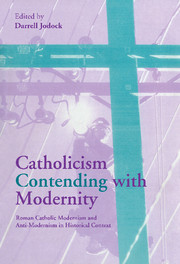 Catholicism Contending with Modernity
Catholicism Contending with Modernity Book contents
- Frontmatter
- Contents
- List of contributors
- Acknowledgments
- List of abbreviations
- Note on the text
- Introduction I: The Modernist crisis
- Introduction II: The Modernists and the anti-Modernists
- PART I THE LATE NINETEENTH-CENTURY SETTING OF MODERNISM AND ANTI-MODERNISM
- 1 Vatican foreign policy and the origins of Modernism
- 2 Catholic anti-Modernism: the ecclesial setting
- 3 Theological and philosophical Modernism
- PART II MAURICE BLONDEL AND ALFRED LOISY IN FRANCE
- PART III FRIEDRICH VON HÜGEL AND MAUDE PETRE IN ENGLAND
- PART IV SOCIAL MODERNISM AND ANTI-MODERNISM IN FRANCE
- Conclusion
- Index
2 - Catholic anti-Modernism: the ecclesial setting
Published online by Cambridge University Press: 30 October 2009
- Frontmatter
- Contents
- List of contributors
- Acknowledgments
- List of abbreviations
- Note on the text
- Introduction I: The Modernist crisis
- Introduction II: The Modernists and the anti-Modernists
- PART I THE LATE NINETEENTH-CENTURY SETTING OF MODERNISM AND ANTI-MODERNISM
- 1 Vatican foreign policy and the origins of Modernism
- 2 Catholic anti-Modernism: the ecclesial setting
- 3 Theological and philosophical Modernism
- PART II MAURICE BLONDEL AND ALFRED LOISY IN FRANCE
- PART III FRIEDRICH VON HÜGEL AND MAUDE PETRE IN ENGLAND
- PART IV SOCIAL MODERNISM AND ANTI-MODERNISM IN FRANCE
- Conclusion
- Index
Summary
Of the various settings or contexts that shaped the Modernist crisis in Roman Catholicism a century ago, none was closer to the bone of the protagonists than church life itself. The Modernists were, after all, engaged in what they saw as a necessary church reform movement. Their concern was with the intellectual vigor of Catholicism in the modern world. The most conspicuous element in their immediate church context was the “obscurantism” (Wilfrid Ward) that they ran up against in infuential circles. The degree to which it gained the upper hand, making a crisis out of a controversy, requires explanation.
After all, the Modernists' pursuits were predominantly “academic.” They scarcely touched upon the burning issues of church and state that preoccupied bishops and curial officials. Moreover, Pope Leo XIII (pope from 1878 to 1903) was calling for a renewal of ecclesiastical studies to bring them up to par with the challenges of the modern world. In these circumstances, reform-minded scholars who were ecclesiastics could well have expected some elbowroom for revising conventional positions. The mobilization of anti-Modernism was so effective, nevertheless, that a full battery of papal condemnations was loosed upon them in the pontificate of Pius X (1903–1914), especially from 1907 onwards. Where did this anti-Modernism come from? What were its sources of strength within the Catholic communion?
- Type
- Chapter
- Information
- Catholicism Contending with ModernityRoman Catholic Modernism and Anti-Modernism in Historical Context, pp. 56 - 87Publisher: Cambridge University PressPrint publication year: 2000
